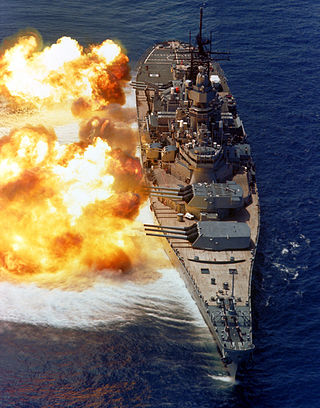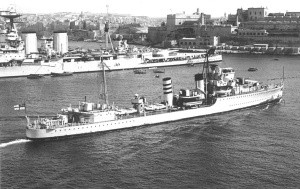External links
-
 Works related to The Ballad of the "Clampherdown" at Wikisource
Works related to The Ballad of the "Clampherdown" at Wikisource
"The Ballad of the 'Clampherdown'" is a satirical poem written by Rudyard Kipling in 1892.
The poem describes an engagement between the Clampherdown, a fictional Royal Navy battleship, and a light cruiser of indeterminate origin; she is described as "of the ancient foe", and carrying "a dainty Hotchkiss gun", which implies the French Navy. After the Clampherdown's guns fail to sink the cruiser, and she drifts aimlessly being shelled, she collides with the cruiser, and her crew "out cutlasses, and board!" the enemy.
It was inspired by a letter written to the St James's Gazette , whose author "seemed to believe that naval warfare of the future would be conducted on the old Nelsonic battle lines, including boarding, etc.", to quote Kipling's explanation. He wrote the poem as a deliberate humorous play on this idea; however, to his surprise, it was taken quite seriously and published. Whilst boarding did never return as a major part of naval warfare, it did occur occasionally. The last major boarding action by the Royal Navy was the Altmark incident, in 1940.
The Clampherdown is described in some detail in the poem, allowing some comparison to be made to real vessels. Whilst the name is similar to HMS Camperdown, the physical description—"one bow-gun of a hundred ton / and a great stern-gun beside"—is closer to that of her sister ship Benbow, which was built with an experimental armament. Both were Admiral-class battleships, pre-dreadnoughts launched in the 1880s. The 16.25-inch guns of Benbow, the largest and most powerful then fitted to a Royal Navy battleship, were not greatly successful in service; they took four or five minutes to load and fire, the barrels only had a life of 75 rounds, and the muzzles tended to droop. The ships of this class were only partially armoured, with the bow and stern being lightly protected, and had low freeboard; these factors are noted and reflected in the text. In 1892, Benbow had recently been removed from active service and was serving as a guard ship at Greenock; the defects in her design would have been clear by this point.

A battleship is a large, heavily armored warship with a main battery consisting of large-caliber guns, designed to serve as capital ships with the most intense firepower. Before the rise of supercarriers, battleships were among the largest and most formidable weapon systems ever built.

The battlecruiser was a type of capital ship of the first half of the 20th century. These were similar in displacement, armament and cost to battleships, but differed in form and balance of attributes. Battlecruisers typically had thinner armour and a somewhat lighter main gun battery than contemporary battleships, installed on a longer hull with much higher engine power in order to attain greater speeds. The first battlecruisers were designed in the United Kingdom, as a development of the armoured cruiser, at the same time as the dreadnought succeeded the pre-dreadnought battleship. The goal of the design was to outrun any ship with similar armament, and chase down any ship with lesser armament; they were intended to hunt down slower, older armoured cruisers and destroy them with heavy gunfire while avoiding combat with the more powerful but slower battleships. However, as more and more battlecruisers were built, they were increasingly used alongside the better-protected battleships.

In naval terminology, a destroyer is a fast, maneuverable, long-endurance warship intended to escort larger vessels in a fleet, convoy, or carrier battle group and defend them against a wide range of general threats. They were originally conceived in 1885 by Fernando Villaamil for the Spanish Navy as a defense against torpedo boats, and by the time of the Russo-Japanese War in 1904, these "torpedo boat destroyers" (TBDs) were "large, swift, and powerfully armed torpedo boats designed to destroy other torpedo boats". Although the term "destroyer" had been used interchangeably with "TBD" and "torpedo boat destroyer" by navies since 1892, the term "torpedo boat destroyer" had been generally shortened to simply "destroyer" by nearly all navies by the First World War.

A torpedo boat is a relatively small and fast naval ship designed to carry torpedoes into battle. The first designs were steam-powered craft dedicated to ramming enemy ships with explosive spar torpedoes. Later evolutions launched variants of self-propelled Whitehead torpedoes.

A ship of the line was a type of naval warship constructed during the Age of Sail from the 17th century to the mid-19th century. The ship of the line was designed for the naval tactic known as the line of battle, which involved the two columns of opposing warships manoeuvering to volley fire with the cannons along their broadsides. In conflicts where opposing ships were both able to fire from their broadsides, the faction with more cannons firing – and therefore more firepower – typically had an advantage.

The armored cruiser was a type of warship of the late 19th and early 20th centuries. It was designed like other types of cruisers to operate as a long-range, independent warship, capable of defeating any ship apart from a battleship and fast enough to outrun any battleship it encountered.

Protected cruisers, a type of cruising warship of the late 19th century, gained their description because an armored deck offered protection for vital machine-spaces from fragments caused by shells exploding above them. Protected cruisers notably lacked a belt of armour along the sides, in contrast to armored cruisers which carried both deck and belt armour. Protected cruisers were typically lighter in displacement and mounted fewer and/or lighter guns than armored cruisers. By the early 20th-century, with the advent of increasingly lighter yet stronger armour, even smaller vessels could afford some level of both belt and deck armour. In the place of protected cruisers, armored cruisers would evolve into heavy cruisers and light cruisers, the latter especially taking-up many of roles originally envisaged for that of protected cruisers.

A warship or combatant ship is a ship that is used for naval warfare. Usually they belong to the navy branch of the armed forces of a nation, though they have also been operated by individuals, cooperatives and corporations. As well as being armed, warships are designed to withstand damage and are typically faster and more maneuverable than merchant ships. Unlike a merchant ship, which carries cargo, a warship typically carries only weapons, ammunition and supplies for its crew.

HMS Inglefield was an I-class destroyer leader built for the Royal Navy that served during World War II. She was the navy's last purpose-built flotilla leader. She was named after the 19th century Admiral Sir Edward Augustus Inglefield (1820–1894), and is so far the only warship to carry the name of that seafaring family. In May 1940, her pennant number was changed to I02.

HMS Benbow was the third of four Iron Duke-class battleships of the Royal Navy, the third ship to be named in honour of Admiral John Benbow. Ordered in the 1911 building programme, the ship was laid down at the William Beardmore and Company shipyard in May 1912, was launched in November 1913, and was completed in October 1914, shortly after the outbreak of the First World War. The four Iron Dukes were very similar to the preceding King George V class, with an improved secondary battery. She was armed with a main battery of ten 13.5-inch (343 mm) guns and twelve 6 in (152 mm) secondary guns. The ship was capable of a top speed of 21.25 knots, and had a 12-inch (305 mm) thick armoured belt.

The Tribal class, or Afridi class, was a class of destroyers built for the Royal Navy, Royal Canadian Navy and Royal Australian Navy that saw service in World War II. Originally conceived during design studies for a light fleet cruiser, the Tribals evolved into fast, powerful destroyers, with greater emphasis on guns over torpedoes than previous destroyers, in response to new designs by Japan, Italy, and Germany. The Tribals were well admired by their crews and the public when they were in service due to their power, often becoming symbols of prestige while in service.

The Kongō-class battlecruiser was a class of four battlecruisers built for the Imperial Japanese Navy (IJN) immediately before World War I. Designed by British naval architect George Thurston, the lead ship of the class, Kongō, was the last Japanese capital ship constructed outside Japan, by Vickers at Barrow-in-Furness. Her sister ships, Haruna, Kirishima and Hiei, were all completed in Japan.

Duilio was the lead ship of the Duilio class of ironclad turret ships built for the Italian Regia Marina. Named for the Roman admiral Gaius Duilius, the ship was laid down in January 1873, was launched in May 1876, and was completed in January 1880. She was armed with a main battery of four 450 mm (17.7 in) guns, then the largest gun afloat, and she was capable of a top speed of around 15 knots.

HMS Agamemnon was a Victorian Royal Navy Ajax-class ironclad turret battleship, the sister ship of HMS Ajax. Agamemnon and Ajax were built to the same design, and were smaller and less expensive versions of Inflexible. The class is known as the Ajax class because Ajax was laid down first although Agamemnon was completed one day before her sister.

HMS Centurion was the lead ship of her class of two pre-dreadnought battleships built for the Royal Navy in the 1890s. Intended for service abroad, they exchanged heavy armour and a powerful armament for high speed and long range to counter the foreign armoured cruisers then being built as commerce raiders and were rated as second-class battleships.

Roma, named after two previous ships and the city of Rome, was the third Littorio-class battleship of Italy's Regia Marina. The construction of both Roma and her sister ship Impero was due to rising tensions around the world and the navy's fear that only two Littorios, even in company with older pre-First World War battleships, would not be enough to counter the British and French Mediterranean fleets in case of a possible Franco-British alliance. As Roma was laid down almost four years after the first two ships of the class, some small improvements were made to the design, including additional freeboard added to the bow.

HMS Kipling (F91) was a K-class destroyer built for the Royal Navy during the 1930s.

Giovanni Bausan was a protected cruiser of the Italian Regia Marina that was designed and built by Sir W G Armstrong Mitchell & Co.'s Elswick Works in England in the mid-1880s. The finished ship entered service in May 1885. She was the first ship of this type to be built for the Italian fleet, and she provided the basis for subsequent designs built in Italy, including the Etna class. Giovanni Bausan was intended to serve as a "battleship destroyer", and was armed with a main battery of two 10-inch (254 mm) guns to give her the ability to defeat heavy armor, but design flaws rendered her unfit for this role.

Davout was a protected cruiser of the French Navy that was built in the late 1880s and early 1890s. The ship was ordered during the tenure of Admiral Théophile Aube as the French Minister of Marine, who favored a fleet centered on large numbers of cruisers of various types. Davout and the similar vessel Suchet were ordered to fill the role of a medium cruiser in Aube's plans. Davout was armed with a main battery of six 164 mm (6.5 in) guns in single mounts, and she had a top speed of 20.7 knots.